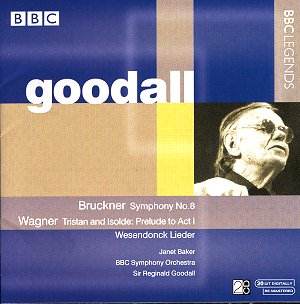It was at the time of these performances that the conducting
of Reginald Goodall was recognised as having a special significance
in the Wagnerian and associated repertory. Most of all this was due
to his performances of The Ring at English National Opera, but
he gave concert performances which also showed his special talent. Some
of these performances are gathered on this pair of CDs.
The Bruckner Symphony No. 8 was recorded at the Proms
in 1969. The sound emerges as satisfactory if not outstanding, but it
is certainly good enough to represent the music accurately and give
much pleasure to the listener. What it lacks is the kind of sophisticated
range, depth and bloom which more recent recordings can bring, not least
the latest offering from Günter Wand (RCA 74321 82866 2).
This is a large scale symphony of course, and the majority
of recorded performances are spread across two CDs. Wand takes 87 minutes,
for example, and Goodall 89, whereas the live recording from St Florian,
conducted by Pierre Boulez (DGG 459 678-2) is, like his Wagner, remarkably
lithe and swift at only 76 minutes. But there is no particular problem
about all this. Any great work is always greater than any one view of
it, and we should be grateful for the insights offered by each performance,
rather than feel there is only one way.
So what is Goodall's way? His view is spacious, as
we might expect of him. The music unfolds as some great expository ritual,
with a solemn mood and committed playing from the BBC Symphony Orchestra.
In the first movement the music seems less atmospheric than it might
be, partly because of the acoustic and the occasional contributions
from the audience (which recur throughout the work). But this does not
present the strength of Bruckner's symphonic credentials from making
its mark. The final climax has great power, releasing the dark coda,
which was added for the 1890 revision, which the composer described
as a totenuhr (death-watch).
Goodall brings strength and stolidity to the rhythmic
thrust of the scherzo, and the lighter trio has a suitable contrast
of approach with its lilting approach. But the heart of this symphony
is the slow movement, an extended movement nearly half and hour long.
Goodall has its measure, and shapes the architecture particularly well.
As a result the powerful climaxes emerge strongly and naturally, although
the rhythmic and textural subtleties are treated with a little more
imagination by Wand, whose insights into appropriate phrasing and rubato
always add a special dimension.
It is in the finale where most doubts about Goodall's
interpretation occur. Again the performance is strong, the tempi deliberate
and slower than the norm. Nothing wrong with that of course, but I do
feel the music needs more sheer attack to generate the tensions whose
ultimate resolution is the work's true goal. In his concluding section,
Bruckner combines all the principal material from all four movements,
in his ultimate display of contrapuntal mastery. Here Goodall's monumental
approach has great benefit, and the conclusion is very powerful indeed,
and worthy of the composer's great achievement.
The two Wagner items are both extremely satisfying.
Goodall always had a
special understanding of Tristan und Isolde,
and this performance of the Prelude, recorded live at the Royal Festival
Hall in atmospheric sound, has that mystery and intensity associated
particularly with this work. In the Wesendonck Lieder the singer
is Dame Janet Baker, then at the height of her powers and in marvellous
voice. Therefore the performance is quite splendid, deeply felt and
atmospheric in every way. If only the texts and translations had been
included.
Terry Barfoot


